Leadership Styles, Management Impact and Strategy for Nexus Report
VerifiedAdded on 2020/01/15
|11
|3075
|163
Report
AI Summary
This report provides a comprehensive analysis of leadership and management styles, focusing on their impact within the context of Nexus, Nokia, Samsung, and Microsoft. The report begins with an introduction to strategic management and leadership, defining key concepts and their significance in organizational success. It then delves into the analysis of different leadership styles, including autocratic, democratic, participative, and persuasive approaches, and evaluates their impact on Nexus. Furthermore, the report examines the adaptation of leadership styles in various situations within Nexus. It also explores the influence of participative and transformational leadership theories on Nokia and Samsung, respectively. Finally, the report presents a future leadership strategy for Microsoft, outlining methods and expected outcomes. This analysis aims to provide insights into effective leadership practices and their role in driving organizational growth and achieving strategic objectives.
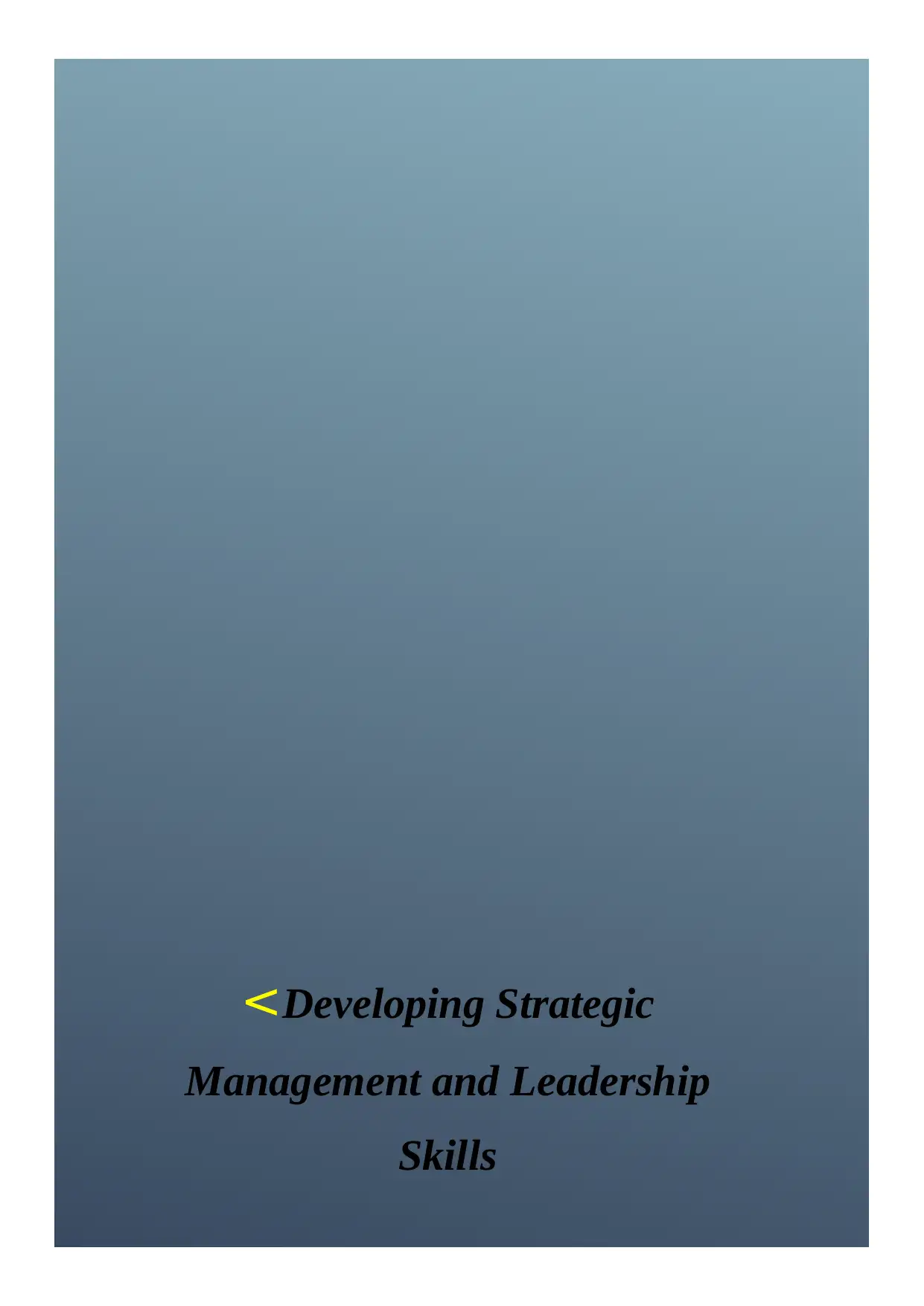
<Developing Strategic
Management and Leadership
Skills
Management and Leadership
Skills
Paraphrase This Document
Need a fresh take? Get an instant paraphrase of this document with our AI Paraphraser
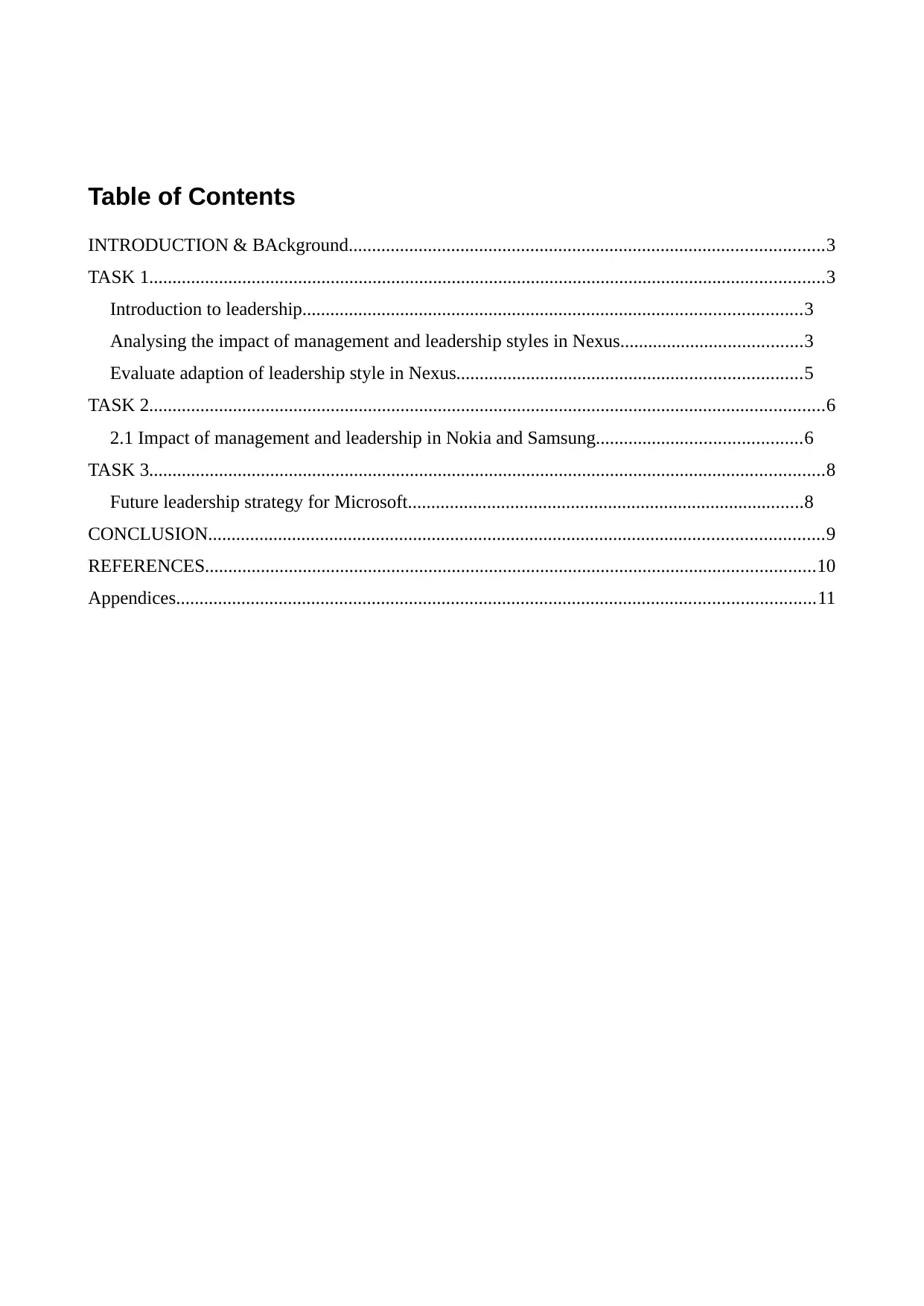
Table of Contents
INTRODUCTION & BAckground......................................................................................................3
TASK 1.................................................................................................................................................3
Introduction to leadership...........................................................................................................3
Analysing the impact of management and leadership styles in Nexus.......................................3
Evaluate adaption of leadership style in Nexus..........................................................................5
TASK 2.................................................................................................................................................6
2.1 Impact of management and leadership in Nokia and Samsung............................................6
TASK 3.................................................................................................................................................8
Future leadership strategy for Microsoft.....................................................................................8
CONCLUSION....................................................................................................................................9
REFERENCES...................................................................................................................................10
Appendices.........................................................................................................................................11
INTRODUCTION & BAckground......................................................................................................3
TASK 1.................................................................................................................................................3
Introduction to leadership...........................................................................................................3
Analysing the impact of management and leadership styles in Nexus.......................................3
Evaluate adaption of leadership style in Nexus..........................................................................5
TASK 2.................................................................................................................................................6
2.1 Impact of management and leadership in Nokia and Samsung............................................6
TASK 3.................................................................................................................................................8
Future leadership strategy for Microsoft.....................................................................................8
CONCLUSION....................................................................................................................................9
REFERENCES...................................................................................................................................10
Appendices.........................................................................................................................................11
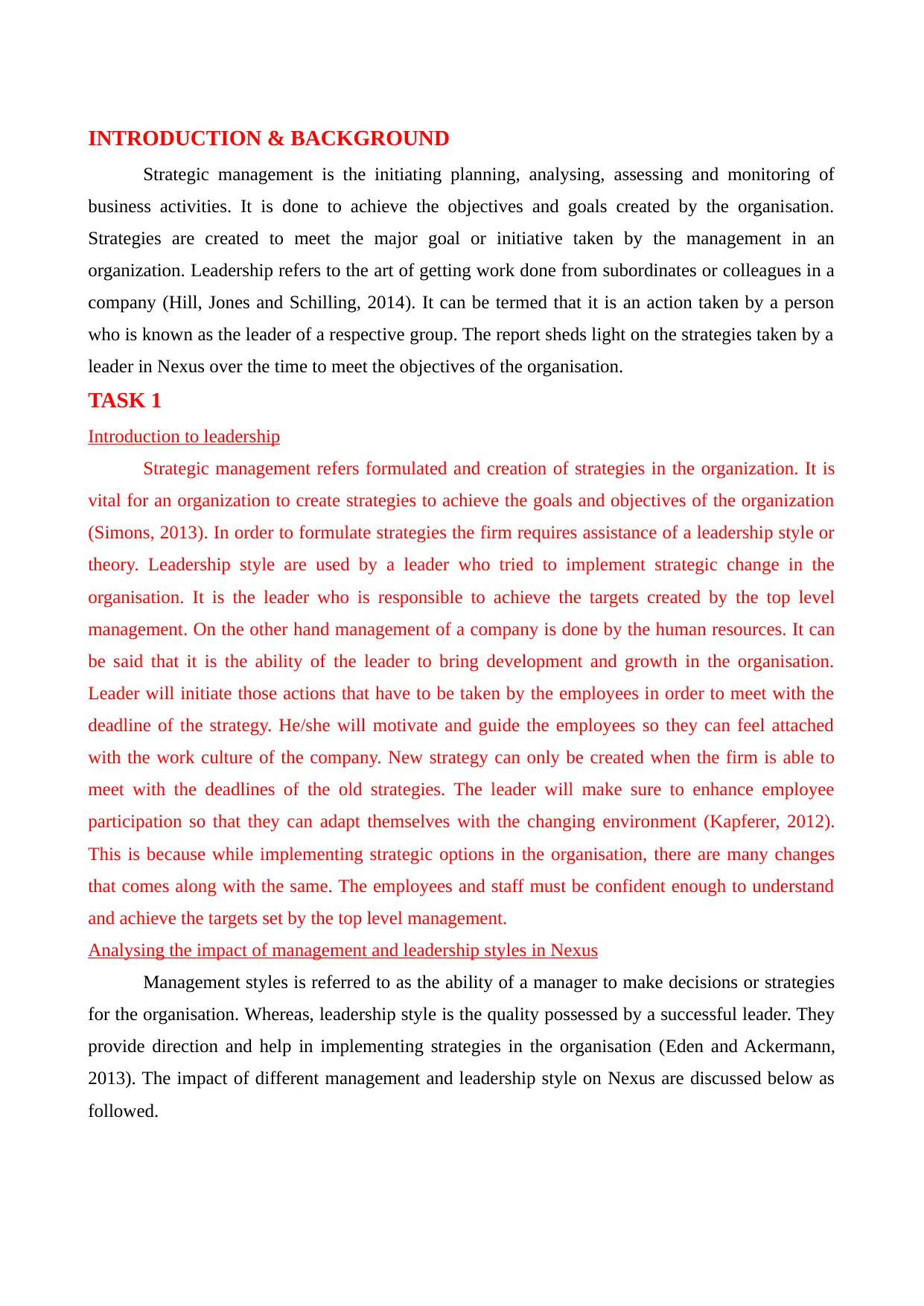
INTRODUCTION & BACKGROUND
Strategic management is the initiating planning, analysing, assessing and monitoring of
business activities. It is done to achieve the objectives and goals created by the organisation.
Strategies are created to meet the major goal or initiative taken by the management in an
organization. Leadership refers to the art of getting work done from subordinates or colleagues in a
company (Hill, Jones and Schilling, 2014). It can be termed that it is an action taken by a person
who is known as the leader of a respective group. The report sheds light on the strategies taken by a
leader in Nexus over the time to meet the objectives of the organisation.
TASK 1
Introduction to leadership
Strategic management refers formulated and creation of strategies in the organization. It is
vital for an organization to create strategies to achieve the goals and objectives of the organization
(Simons, 2013). In order to formulate strategies the firm requires assistance of a leadership style or
theory. Leadership style are used by a leader who tried to implement strategic change in the
organisation. It is the leader who is responsible to achieve the targets created by the top level
management. On the other hand management of a company is done by the human resources. It can
be said that it is the ability of the leader to bring development and growth in the organisation.
Leader will initiate those actions that have to be taken by the employees in order to meet with the
deadline of the strategy. He/she will motivate and guide the employees so they can feel attached
with the work culture of the company. New strategy can only be created when the firm is able to
meet with the deadlines of the old strategies. The leader will make sure to enhance employee
participation so that they can adapt themselves with the changing environment (Kapferer, 2012).
This is because while implementing strategic options in the organisation, there are many changes
that comes along with the same. The employees and staff must be confident enough to understand
and achieve the targets set by the top level management.
Analysing the impact of management and leadership styles in Nexus
Management styles is referred to as the ability of a manager to make decisions or strategies
for the organisation. Whereas, leadership style is the quality possessed by a successful leader. They
provide direction and help in implementing strategies in the organisation (Eden and Ackermann,
2013). The impact of different management and leadership style on Nexus are discussed below as
followed.
Strategic management is the initiating planning, analysing, assessing and monitoring of
business activities. It is done to achieve the objectives and goals created by the organisation.
Strategies are created to meet the major goal or initiative taken by the management in an
organization. Leadership refers to the art of getting work done from subordinates or colleagues in a
company (Hill, Jones and Schilling, 2014). It can be termed that it is an action taken by a person
who is known as the leader of a respective group. The report sheds light on the strategies taken by a
leader in Nexus over the time to meet the objectives of the organisation.
TASK 1
Introduction to leadership
Strategic management refers formulated and creation of strategies in the organization. It is
vital for an organization to create strategies to achieve the goals and objectives of the organization
(Simons, 2013). In order to formulate strategies the firm requires assistance of a leadership style or
theory. Leadership style are used by a leader who tried to implement strategic change in the
organisation. It is the leader who is responsible to achieve the targets created by the top level
management. On the other hand management of a company is done by the human resources. It can
be said that it is the ability of the leader to bring development and growth in the organisation.
Leader will initiate those actions that have to be taken by the employees in order to meet with the
deadline of the strategy. He/she will motivate and guide the employees so they can feel attached
with the work culture of the company. New strategy can only be created when the firm is able to
meet with the deadlines of the old strategies. The leader will make sure to enhance employee
participation so that they can adapt themselves with the changing environment (Kapferer, 2012).
This is because while implementing strategic options in the organisation, there are many changes
that comes along with the same. The employees and staff must be confident enough to understand
and achieve the targets set by the top level management.
Analysing the impact of management and leadership styles in Nexus
Management styles is referred to as the ability of a manager to make decisions or strategies
for the organisation. Whereas, leadership style is the quality possessed by a successful leader. They
provide direction and help in implementing strategies in the organisation (Eden and Ackermann,
2013). The impact of different management and leadership style on Nexus are discussed below as
followed.
⊘ This is a preview!⊘
Do you want full access?
Subscribe today to unlock all pages.

Trusted by 1+ million students worldwide
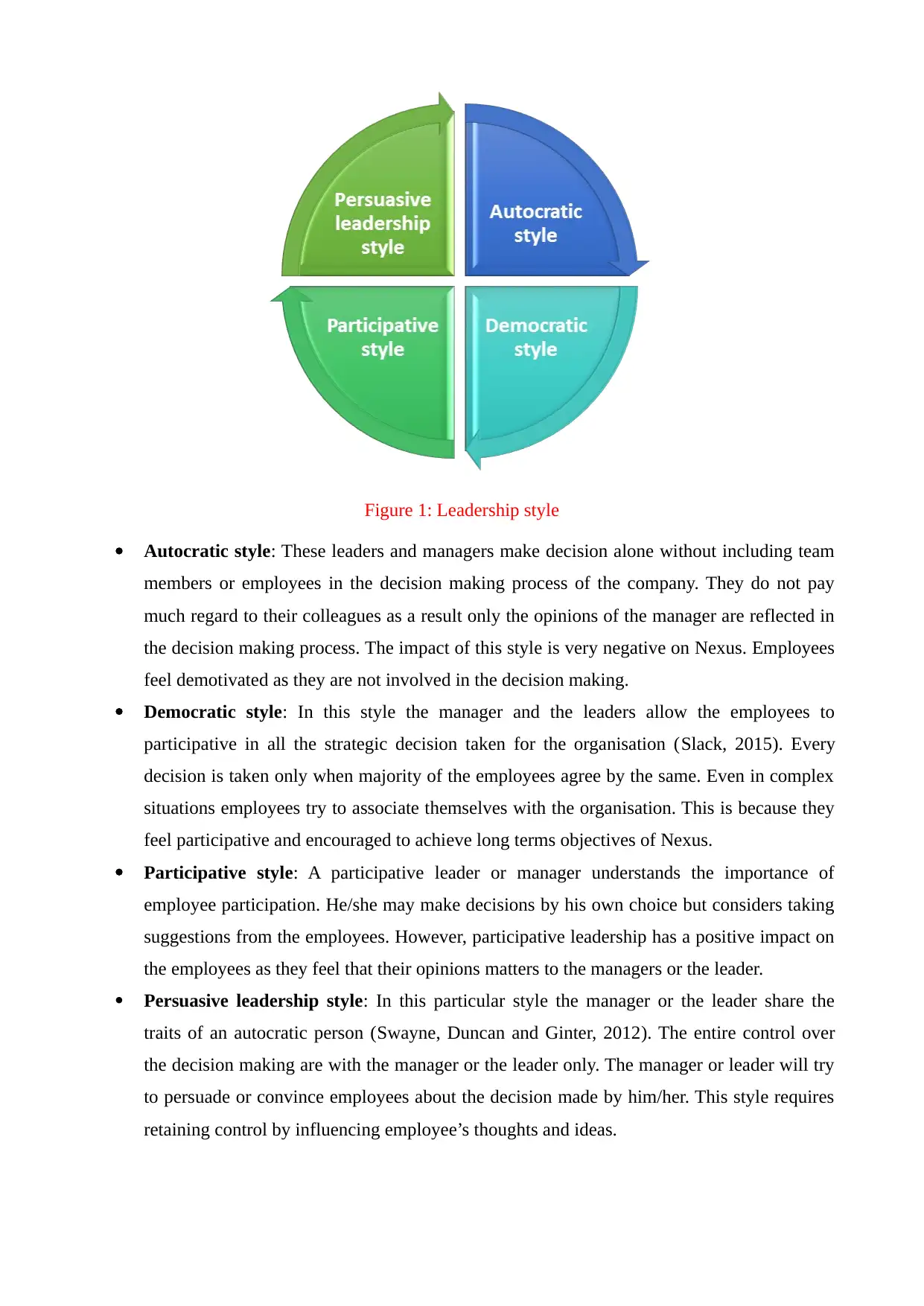
Figure 1: Leadership style
Autocratic style: These leaders and managers make decision alone without including team
members or employees in the decision making process of the company. They do not pay
much regard to their colleagues as a result only the opinions of the manager are reflected in
the decision making process. The impact of this style is very negative on Nexus. Employees
feel demotivated as they are not involved in the decision making.
Democratic style: In this style the manager and the leaders allow the employees to
participative in all the strategic decision taken for the organisation (Slack, 2015). Every
decision is taken only when majority of the employees agree by the same. Even in complex
situations employees try to associate themselves with the organisation. This is because they
feel participative and encouraged to achieve long terms objectives of Nexus.
Participative style: A participative leader or manager understands the importance of
employee participation. He/she may make decisions by his own choice but considers taking
suggestions from the employees. However, participative leadership has a positive impact on
the employees as they feel that their opinions matters to the managers or the leader.
Persuasive leadership style: In this particular style the manager or the leader share the
traits of an autocratic person (Swayne, Duncan and Ginter, 2012). The entire control over
the decision making are with the manager or the leader only. The manager or leader will try
to persuade or convince employees about the decision made by him/her. This style requires
retaining control by influencing employee’s thoughts and ideas.
Autocratic style: These leaders and managers make decision alone without including team
members or employees in the decision making process of the company. They do not pay
much regard to their colleagues as a result only the opinions of the manager are reflected in
the decision making process. The impact of this style is very negative on Nexus. Employees
feel demotivated as they are not involved in the decision making.
Democratic style: In this style the manager and the leaders allow the employees to
participative in all the strategic decision taken for the organisation (Slack, 2015). Every
decision is taken only when majority of the employees agree by the same. Even in complex
situations employees try to associate themselves with the organisation. This is because they
feel participative and encouraged to achieve long terms objectives of Nexus.
Participative style: A participative leader or manager understands the importance of
employee participation. He/she may make decisions by his own choice but considers taking
suggestions from the employees. However, participative leadership has a positive impact on
the employees as they feel that their opinions matters to the managers or the leader.
Persuasive leadership style: In this particular style the manager or the leader share the
traits of an autocratic person (Swayne, Duncan and Ginter, 2012). The entire control over
the decision making are with the manager or the leader only. The manager or leader will try
to persuade or convince employees about the decision made by him/her. This style requires
retaining control by influencing employee’s thoughts and ideas.
Paraphrase This Document
Need a fresh take? Get an instant paraphrase of this document with our AI Paraphraser
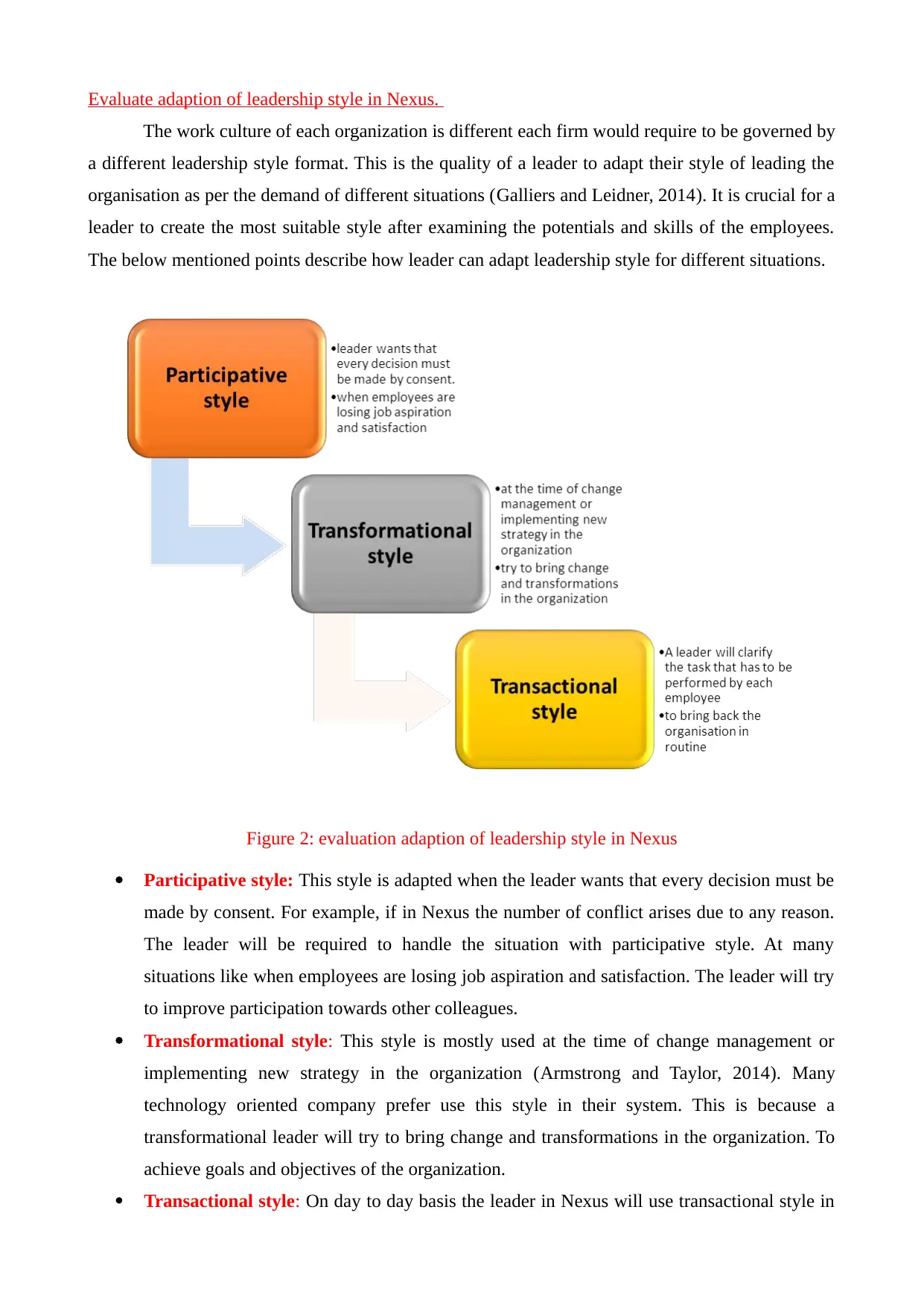
Evaluate adaption of leadership style in Nexus.
The work culture of each organization is different each firm would require to be governed by
a different leadership style format. This is the quality of a leader to adapt their style of leading the
organisation as per the demand of different situations (Galliers and Leidner, 2014). It is crucial for a
leader to create the most suitable style after examining the potentials and skills of the employees.
The below mentioned points describe how leader can adapt leadership style for different situations.
Figure 2: evaluation adaption of leadership style in Nexus
Participative style: This style is adapted when the leader wants that every decision must be
made by consent. For example, if in Nexus the number of conflict arises due to any reason.
The leader will be required to handle the situation with participative style. At many
situations like when employees are losing job aspiration and satisfaction. The leader will try
to improve participation towards other colleagues.
Transformational style: This style is mostly used at the time of change management or
implementing new strategy in the organization (Armstrong and Taylor, 2014). Many
technology oriented company prefer use this style in their system. This is because a
transformational leader will try to bring change and transformations in the organization. To
achieve goals and objectives of the organization.
Transactional style: On day to day basis the leader in Nexus will use transactional style in
The work culture of each organization is different each firm would require to be governed by
a different leadership style format. This is the quality of a leader to adapt their style of leading the
organisation as per the demand of different situations (Galliers and Leidner, 2014). It is crucial for a
leader to create the most suitable style after examining the potentials and skills of the employees.
The below mentioned points describe how leader can adapt leadership style for different situations.
Figure 2: evaluation adaption of leadership style in Nexus
Participative style: This style is adapted when the leader wants that every decision must be
made by consent. For example, if in Nexus the number of conflict arises due to any reason.
The leader will be required to handle the situation with participative style. At many
situations like when employees are losing job aspiration and satisfaction. The leader will try
to improve participation towards other colleagues.
Transformational style: This style is mostly used at the time of change management or
implementing new strategy in the organization (Armstrong and Taylor, 2014). Many
technology oriented company prefer use this style in their system. This is because a
transformational leader will try to bring change and transformations in the organization. To
achieve goals and objectives of the organization.
Transactional style: On day to day basis the leader in Nexus will use transactional style in
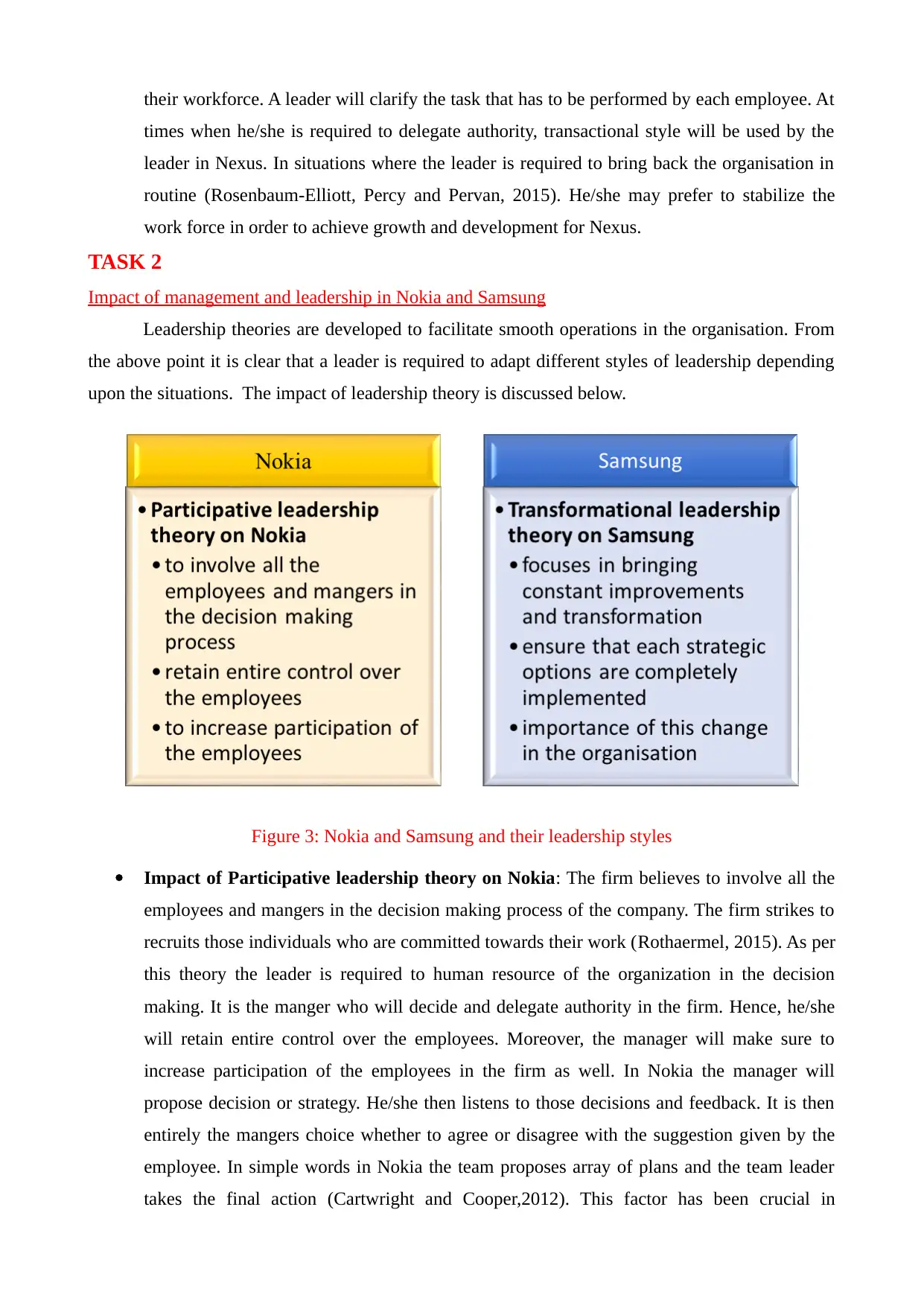
their workforce. A leader will clarify the task that has to be performed by each employee. At
times when he/she is required to delegate authority, transactional style will be used by the
leader in Nexus. In situations where the leader is required to bring back the organisation in
routine (Rosenbaum-Elliott, Percy and Pervan, 2015). He/she may prefer to stabilize the
work force in order to achieve growth and development for Nexus.
TASK 2
Impact of management and leadership in Nokia and Samsung
Leadership theories are developed to facilitate smooth operations in the organisation. From
the above point it is clear that a leader is required to adapt different styles of leadership depending
upon the situations. The impact of leadership theory is discussed below.
Figure 3: Nokia and Samsung and their leadership styles
Impact of Participative leadership theory on Nokia: The firm believes to involve all the
employees and mangers in the decision making process of the company. The firm strikes to
recruits those individuals who are committed towards their work (Rothaermel, 2015). As per
this theory the leader is required to human resource of the organization in the decision
making. It is the manger who will decide and delegate authority in the firm. Hence, he/she
will retain entire control over the employees. Moreover, the manager will make sure to
increase participation of the employees in the firm as well. In Nokia the manager will
propose decision or strategy. He/she then listens to those decisions and feedback. It is then
entirely the mangers choice whether to agree or disagree with the suggestion given by the
employee. In simple words in Nokia the team proposes array of plans and the team leader
takes the final action (Cartwright and Cooper,2012). This factor has been crucial in
times when he/she is required to delegate authority, transactional style will be used by the
leader in Nexus. In situations where the leader is required to bring back the organisation in
routine (Rosenbaum-Elliott, Percy and Pervan, 2015). He/she may prefer to stabilize the
work force in order to achieve growth and development for Nexus.
TASK 2
Impact of management and leadership in Nokia and Samsung
Leadership theories are developed to facilitate smooth operations in the organisation. From
the above point it is clear that a leader is required to adapt different styles of leadership depending
upon the situations. The impact of leadership theory is discussed below.
Figure 3: Nokia and Samsung and their leadership styles
Impact of Participative leadership theory on Nokia: The firm believes to involve all the
employees and mangers in the decision making process of the company. The firm strikes to
recruits those individuals who are committed towards their work (Rothaermel, 2015). As per
this theory the leader is required to human resource of the organization in the decision
making. It is the manger who will decide and delegate authority in the firm. Hence, he/she
will retain entire control over the employees. Moreover, the manager will make sure to
increase participation of the employees in the firm as well. In Nokia the manager will
propose decision or strategy. He/she then listens to those decisions and feedback. It is then
entirely the mangers choice whether to agree or disagree with the suggestion given by the
employee. In simple words in Nokia the team proposes array of plans and the team leader
takes the final action (Cartwright and Cooper,2012). This factor has been crucial in
⊘ This is a preview!⊘
Do you want full access?
Subscribe today to unlock all pages.

Trusted by 1+ million students worldwide

increasing the growth of the company all the around world. The impact of this theory is that
people particularly in Nokia are less competitive towards each other. When competition
among colleagues decreases, positivity among them increases. The employees fell highly
moraled to achieve the goals and objective set by Nokia rather than paying heed to personal
competition. All the employees along with superiors have better communication among
them. This is because the leader makes sure to involve all the employees in the business
prospects. Thus, all the individual in Nokia know what is happening in the organisation.
They feel motivated and inspired to work under those leaders who understand their value.
This way firm is able to retain employees for a longer period (Abdelhak, Grostick and
Hanken, 2014). Also in this style more than one person provides suggestion thus
productivity increase. Nokia is able to strike for improvements in the products.
Impact of Transformational leadership theory on Samsung: A transformational theory
focuses in bringing constant improvements and transformation in the organisation. The
leader aims to convince the employees that transformation is to success (Daft, 2014). It is
evident in Samsung that the company have strived for innovations. They believe that
constant updates in technology will help them build better customer satisfaction. A
transformational leader will ensure that each strategic options are completely implemented.
An employee understands the importance of this change in the organisation. Thus type of
leader is highly enthusiast towards the work culture. The employees feel happy to work
under such a leader who initiates good quality (Aaker and Joachimsthaler, 2012). Samsung
has been able to achieve its vision and mission due to the same style. This is because
mangers in Samsung plan ahead for the strategic change. He/she develops vision and
motivates the employees to achieve the target and goals of the organisation. Entire work
culture at Samsung is hard working because they are always pumped with enthusiasm. The
employees strictly follows the rules and norms created by their manager. Transformational
leadership theory initiates understanding of empl0tyees needs. This is because the manger
will make sure to identify the potentials of their employees before implementing any change
in the team or department. Samsung achieves its targets as it driven to work in a better way.
The leader will play tactfully by pumping up motivation among the employees. Altogether at
many times the leader feels highly overpowered and may influence their judgement on the
employees (Avolio and Yammarino, 2013). In the same way the energy that motivates them
can be responsible to bring employees productivity down. Transformational leaders care
more to achieve the targets for the organization. Thus, they will make sure that all the
employees meet their deadline within the given period.
people particularly in Nokia are less competitive towards each other. When competition
among colleagues decreases, positivity among them increases. The employees fell highly
moraled to achieve the goals and objective set by Nokia rather than paying heed to personal
competition. All the employees along with superiors have better communication among
them. This is because the leader makes sure to involve all the employees in the business
prospects. Thus, all the individual in Nokia know what is happening in the organisation.
They feel motivated and inspired to work under those leaders who understand their value.
This way firm is able to retain employees for a longer period (Abdelhak, Grostick and
Hanken, 2014). Also in this style more than one person provides suggestion thus
productivity increase. Nokia is able to strike for improvements in the products.
Impact of Transformational leadership theory on Samsung: A transformational theory
focuses in bringing constant improvements and transformation in the organisation. The
leader aims to convince the employees that transformation is to success (Daft, 2014). It is
evident in Samsung that the company have strived for innovations. They believe that
constant updates in technology will help them build better customer satisfaction. A
transformational leader will ensure that each strategic options are completely implemented.
An employee understands the importance of this change in the organisation. Thus type of
leader is highly enthusiast towards the work culture. The employees feel happy to work
under such a leader who initiates good quality (Aaker and Joachimsthaler, 2012). Samsung
has been able to achieve its vision and mission due to the same style. This is because
mangers in Samsung plan ahead for the strategic change. He/she develops vision and
motivates the employees to achieve the target and goals of the organisation. Entire work
culture at Samsung is hard working because they are always pumped with enthusiasm. The
employees strictly follows the rules and norms created by their manager. Transformational
leadership theory initiates understanding of empl0tyees needs. This is because the manger
will make sure to identify the potentials of their employees before implementing any change
in the team or department. Samsung achieves its targets as it driven to work in a better way.
The leader will play tactfully by pumping up motivation among the employees. Altogether at
many times the leader feels highly overpowered and may influence their judgement on the
employees (Avolio and Yammarino, 2013). In the same way the energy that motivates them
can be responsible to bring employees productivity down. Transformational leaders care
more to achieve the targets for the organization. Thus, they will make sure that all the
employees meet their deadline within the given period.
Paraphrase This Document
Need a fresh take? Get an instant paraphrase of this document with our AI Paraphraser
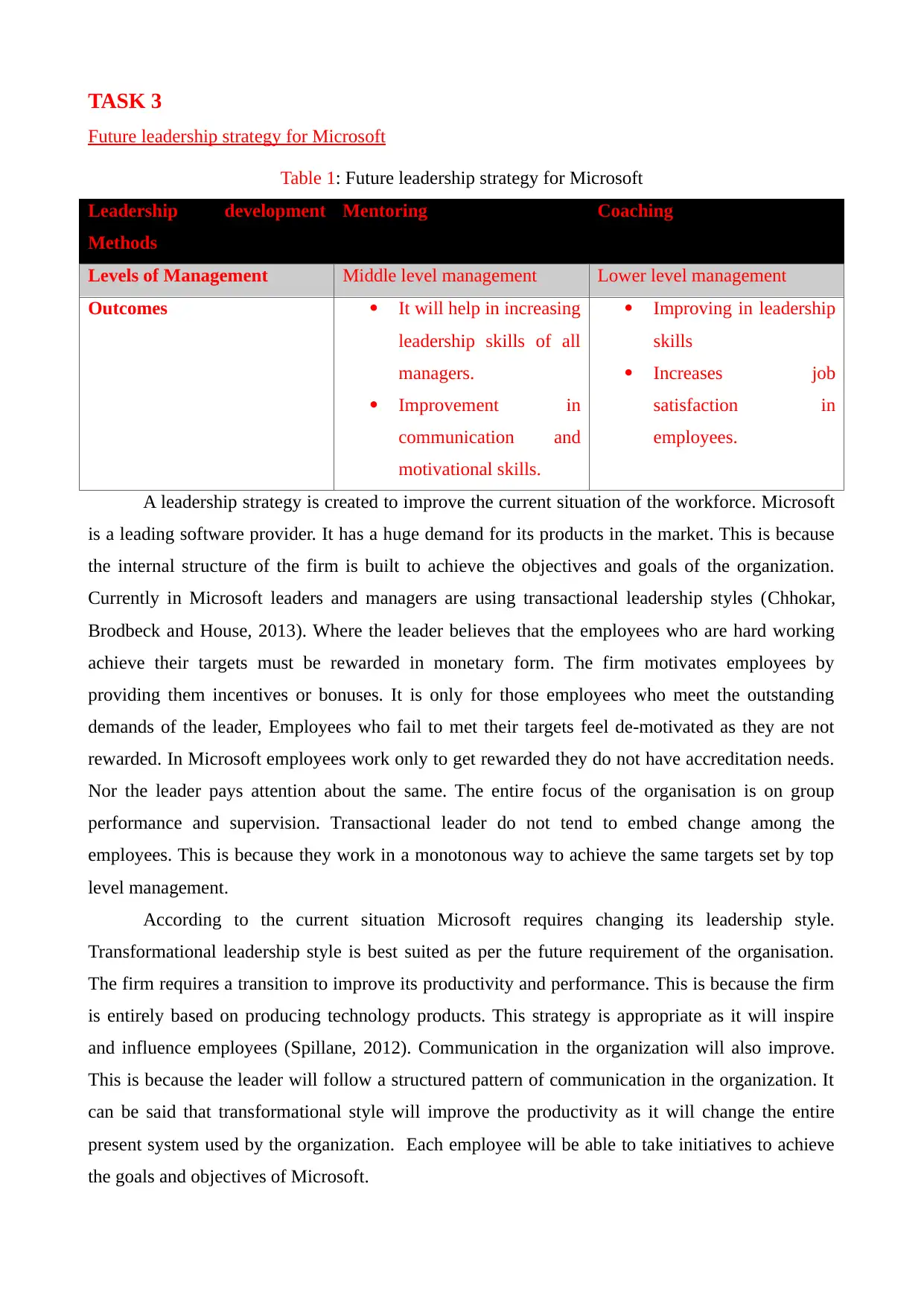
TASK 3
Future leadership strategy for Microsoft
Table 1: Future leadership strategy for Microsoft
Leadership development
Methods
Mentoring Coaching
Levels of Management Middle level management Lower level management
Outcomes It will help in increasing
leadership skills of all
managers.
Improvement in
communication and
motivational skills.
Improving in leadership
skills
Increases job
satisfaction in
employees.
A leadership strategy is created to improve the current situation of the workforce. Microsoft
is a leading software provider. It has a huge demand for its products in the market. This is because
the internal structure of the firm is built to achieve the objectives and goals of the organization.
Currently in Microsoft leaders and managers are using transactional leadership styles (Chhokar,
Brodbeck and House, 2013). Where the leader believes that the employees who are hard working
achieve their targets must be rewarded in monetary form. The firm motivates employees by
providing them incentives or bonuses. It is only for those employees who meet the outstanding
demands of the leader, Employees who fail to met their targets feel de-motivated as they are not
rewarded. In Microsoft employees work only to get rewarded they do not have accreditation needs.
Nor the leader pays attention about the same. The entire focus of the organisation is on group
performance and supervision. Transactional leader do not tend to embed change among the
employees. This is because they work in a monotonous way to achieve the same targets set by top
level management.
According to the current situation Microsoft requires changing its leadership style.
Transformational leadership style is best suited as per the future requirement of the organisation.
The firm requires a transition to improve its productivity and performance. This is because the firm
is entirely based on producing technology products. This strategy is appropriate as it will inspire
and influence employees (Spillane, 2012). Communication in the organization will also improve.
This is because the leader will follow a structured pattern of communication in the organization. It
can be said that transformational style will improve the productivity as it will change the entire
present system used by the organization. Each employee will be able to take initiatives to achieve
the goals and objectives of Microsoft.
Future leadership strategy for Microsoft
Table 1: Future leadership strategy for Microsoft
Leadership development
Methods
Mentoring Coaching
Levels of Management Middle level management Lower level management
Outcomes It will help in increasing
leadership skills of all
managers.
Improvement in
communication and
motivational skills.
Improving in leadership
skills
Increases job
satisfaction in
employees.
A leadership strategy is created to improve the current situation of the workforce. Microsoft
is a leading software provider. It has a huge demand for its products in the market. This is because
the internal structure of the firm is built to achieve the objectives and goals of the organization.
Currently in Microsoft leaders and managers are using transactional leadership styles (Chhokar,
Brodbeck and House, 2013). Where the leader believes that the employees who are hard working
achieve their targets must be rewarded in monetary form. The firm motivates employees by
providing them incentives or bonuses. It is only for those employees who meet the outstanding
demands of the leader, Employees who fail to met their targets feel de-motivated as they are not
rewarded. In Microsoft employees work only to get rewarded they do not have accreditation needs.
Nor the leader pays attention about the same. The entire focus of the organisation is on group
performance and supervision. Transactional leader do not tend to embed change among the
employees. This is because they work in a monotonous way to achieve the same targets set by top
level management.
According to the current situation Microsoft requires changing its leadership style.
Transformational leadership style is best suited as per the future requirement of the organisation.
The firm requires a transition to improve its productivity and performance. This is because the firm
is entirely based on producing technology products. This strategy is appropriate as it will inspire
and influence employees (Spillane, 2012). Communication in the organization will also improve.
This is because the leader will follow a structured pattern of communication in the organization. It
can be said that transformational style will improve the productivity as it will change the entire
present system used by the organization. Each employee will be able to take initiatives to achieve
the goals and objectives of Microsoft.

CONCLUSION
It can be said that in order to archive strategies and goals created by the company
appropriate leadership style is required. Leader is the person who will hep the organization in
meetings its vision and vision. From the above research it is clear that Nexus is required to use
authoritative leadership style. Employees are required to compliance with the aim created by the
company. This can only be done when the team leaders and managers will inspire and enhance their
skills. Thus, it can be concluded that leaders play a vital role in shaping the workforce and culture
of the organization.
It can be said that in order to archive strategies and goals created by the company
appropriate leadership style is required. Leader is the person who will hep the organization in
meetings its vision and vision. From the above research it is clear that Nexus is required to use
authoritative leadership style. Employees are required to compliance with the aim created by the
company. This can only be done when the team leaders and managers will inspire and enhance their
skills. Thus, it can be concluded that leaders play a vital role in shaping the workforce and culture
of the organization.
⊘ This is a preview!⊘
Do you want full access?
Subscribe today to unlock all pages.

Trusted by 1+ million students worldwide

REFERENCES
Books and Journal
Aaker, D.A. and Joachimsthaler, E., 2012. Brand leadership. Simon and Schuster.
Abdelhak, M., Grostick, S. and Hanken, M.A., 2014. Health information: management of a
strategic resource. Elsevier Health Sciences.
Armstrong, M. and Taylor, S., 2014. Armstrong's handbook of human resource management
practice. Kogan Page Publishers.
Avolio, B.J. and Yammarino, F.J. eds., 2013. Transformational and charismatic leadership: The
road ahead. Emerald Group Publishing.
Cartwright, S. and Cooper, C.L., 2012. Managing Mergers Acquisitions and Strategic Alliances.
Routledge.
Chemers, M., 2014. An integrative theory of leadership. Psychology Press.
Chhokar, J.S., Brodbeck, F.C. and House, R.J. eds., 2013. Culture and leadership across the world:
The GLOBE book of in-depth studies of 25 societies. Routledge.
Daft, R., 2014. The leadership experience. Cengage Learning.
Eden, C. and Ackermann, F., 2013. Making strategy: The journey of strategic management. Sage.
Frohlich, N. and Oppenheimer, J.A., 2015. Political leadership and collective goods. Princeton
University Press.
Galliers, R.D. and Leidner, D.E., 2014. Strategic information management: challenges and
strategies in managing information systems. Routledge.
Hargreaves, A. and Fink, D., 2012. Sustainable leadership. Vol. 6. John Wiley & Sons.
Hill, C., Jones, G. and Schilling, M., 2014. Strategic management: theory: an integrated approach.
Cengage Learning.
Kapferer, J.N., 2012. The new strategic brand management: Advanced insights and strategic
thinking. Kogan page publishers.
Rosenbaum-Elliott, R., Percy, L. and Pervan, S., 2015. Strategic brand management. Oxford
University Press, USA.
Rothaermel, F.T., 2015. Strategic management. McGraw-Hill.
Shapiro, J.P. and Stefkovich, J.A., 2016. Ethical leadership and decision making in education:
Applying theoretical perspectives to complex dilemmas. Routledge.
Simons, R., 2013. Levers of control: how managers use innovative control systems to drive
strategic renewal. Harvard Business Press.
Slack, N., 2015. Operations strategy. John Wiley & Sons, Ltd.
Spillane, J.P., 2012. Distributed leadership. 4. John Wiley & Sons.
Swayne, L.E., Duncan, W.J. and Ginter, P.M., 2012. Strategic management of health care
organizations. John Wiley & Sons.
Tannenbaum, R., Weschler, I. and Massarik, F., 2013. Leadership and organization. Routledge.
Verba, S., 2015. Small groups and political behavior: A study of leadership. Princeton University
Press.
Online
6 Leadership Styles, And When You Should Use Them. 2012. [Online]. Available through:
<http://www.fastcompany.com/1838481/6-leadership-styles-and-when-you-should-use-
them>. [Accessed on: 19th February, 2016].
Sweeney. P., 2013. Innovative Methods to Develop Leaders. [Online]. Available through:
<http://www.clomedia.com/articles/innovative-methods-to-develop-leaders>. [Accessed on:
19th February, 2016].
Books and Journal
Aaker, D.A. and Joachimsthaler, E., 2012. Brand leadership. Simon and Schuster.
Abdelhak, M., Grostick, S. and Hanken, M.A., 2014. Health information: management of a
strategic resource. Elsevier Health Sciences.
Armstrong, M. and Taylor, S., 2014. Armstrong's handbook of human resource management
practice. Kogan Page Publishers.
Avolio, B.J. and Yammarino, F.J. eds., 2013. Transformational and charismatic leadership: The
road ahead. Emerald Group Publishing.
Cartwright, S. and Cooper, C.L., 2012. Managing Mergers Acquisitions and Strategic Alliances.
Routledge.
Chemers, M., 2014. An integrative theory of leadership. Psychology Press.
Chhokar, J.S., Brodbeck, F.C. and House, R.J. eds., 2013. Culture and leadership across the world:
The GLOBE book of in-depth studies of 25 societies. Routledge.
Daft, R., 2014. The leadership experience. Cengage Learning.
Eden, C. and Ackermann, F., 2013. Making strategy: The journey of strategic management. Sage.
Frohlich, N. and Oppenheimer, J.A., 2015. Political leadership and collective goods. Princeton
University Press.
Galliers, R.D. and Leidner, D.E., 2014. Strategic information management: challenges and
strategies in managing information systems. Routledge.
Hargreaves, A. and Fink, D., 2012. Sustainable leadership. Vol. 6. John Wiley & Sons.
Hill, C., Jones, G. and Schilling, M., 2014. Strategic management: theory: an integrated approach.
Cengage Learning.
Kapferer, J.N., 2012. The new strategic brand management: Advanced insights and strategic
thinking. Kogan page publishers.
Rosenbaum-Elliott, R., Percy, L. and Pervan, S., 2015. Strategic brand management. Oxford
University Press, USA.
Rothaermel, F.T., 2015. Strategic management. McGraw-Hill.
Shapiro, J.P. and Stefkovich, J.A., 2016. Ethical leadership and decision making in education:
Applying theoretical perspectives to complex dilemmas. Routledge.
Simons, R., 2013. Levers of control: how managers use innovative control systems to drive
strategic renewal. Harvard Business Press.
Slack, N., 2015. Operations strategy. John Wiley & Sons, Ltd.
Spillane, J.P., 2012. Distributed leadership. 4. John Wiley & Sons.
Swayne, L.E., Duncan, W.J. and Ginter, P.M., 2012. Strategic management of health care
organizations. John Wiley & Sons.
Tannenbaum, R., Weschler, I. and Massarik, F., 2013. Leadership and organization. Routledge.
Verba, S., 2015. Small groups and political behavior: A study of leadership. Princeton University
Press.
Online
6 Leadership Styles, And When You Should Use Them. 2012. [Online]. Available through:
<http://www.fastcompany.com/1838481/6-leadership-styles-and-when-you-should-use-
them>. [Accessed on: 19th February, 2016].
Sweeney. P., 2013. Innovative Methods to Develop Leaders. [Online]. Available through:
<http://www.clomedia.com/articles/innovative-methods-to-develop-leaders>. [Accessed on:
19th February, 2016].
Paraphrase This Document
Need a fresh take? Get an instant paraphrase of this document with our AI Paraphraser

APPENDICES
Figure 4: Product range of Nexus
19th February, 201619th February, 201619th February, 2016].
Figure 4: Product range of Nexus
19th February, 201619th February, 201619th February, 2016].
1 out of 11
Related Documents
Your All-in-One AI-Powered Toolkit for Academic Success.
+13062052269
info@desklib.com
Available 24*7 on WhatsApp / Email
![[object Object]](/_next/static/media/star-bottom.7253800d.svg)
Unlock your academic potential
Copyright © 2020–2025 A2Z Services. All Rights Reserved. Developed and managed by ZUCOL.





